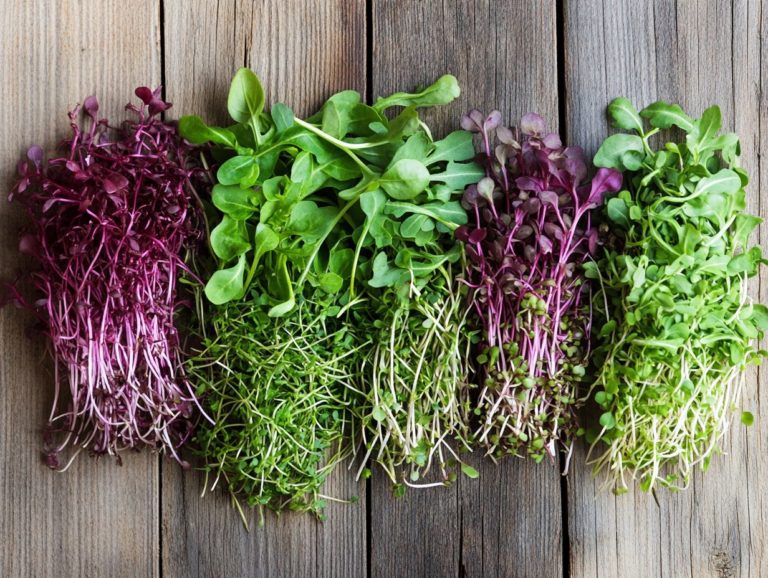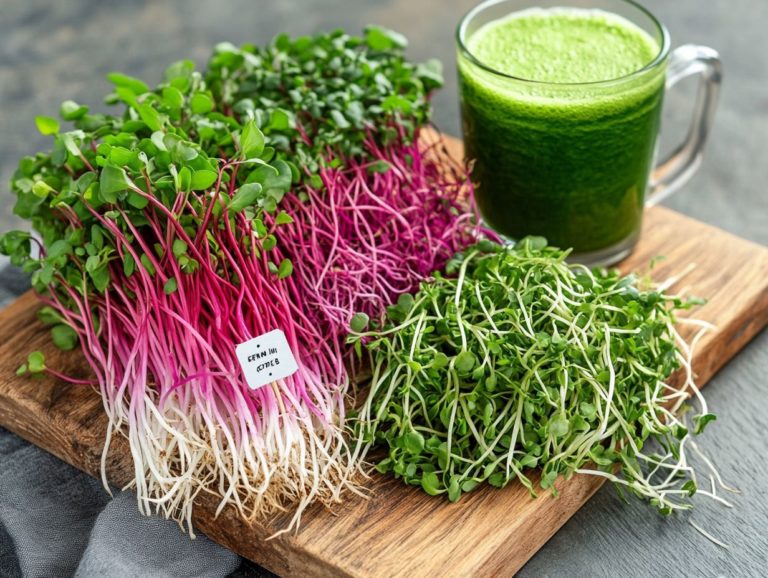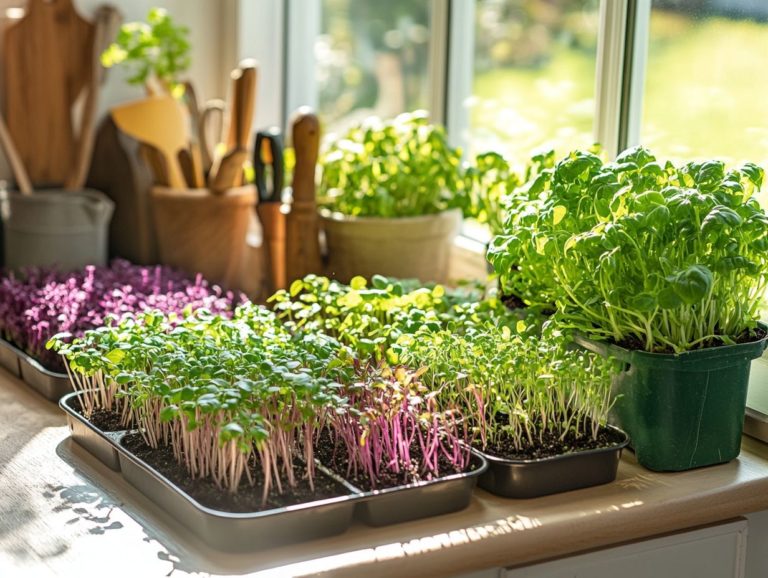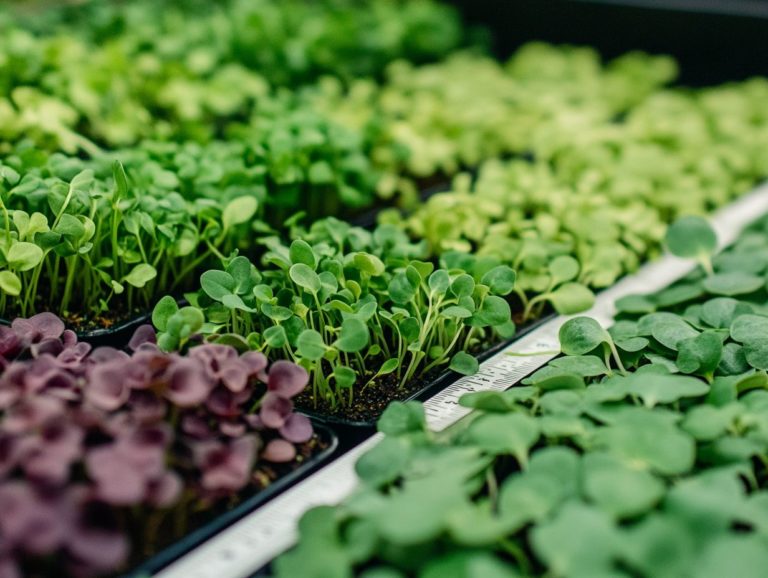5 Microgreen Varieties to Boost Your Smoothies
Want to improve your smoothies? Microgreens are tiny, nutrient-rich plants that can boost both flavor and health benefits.
This article showcases five exceptional varieties kale, broccoli, spinach, pea shoots, and sunflower that can truly transform your favorite drinks.
You ll explore what microgreens are, delve into their impressive nutritional profiles compared to their fully grown counterparts, and learn how to easily cultivate them in the comfort of your own home.
Discover delicious ways to incorporate these vibrant greens into your diet, along with essential tips for safe consumption.
Get ready to blend your way to a healthier, more vibrant you!
Contents
- Key Takeaways:
- 1. Kale Microgreens
- 2. Broccoli Microgreens
- 3. Spinach Microgreens
- 4. Pea Shoot Microgreens
- 5. Sunflower Microgreens
- What Are Microgreens and Why Are They Good for Smoothies?
- How Do Microgreens Compare to Full-Grown Greens in Nutritional Value and Health Benefits?
- How to Grow Microgreens at Home for Smoothies?
- Creative Ways to Add Microgreens to Your Meals
- What Are the Potential Health Benefits of Consuming Microgreens?
- Are There Any Precautions to Take When Consuming Microgreens?
- Frequently Asked Questions
- What are the top 5 microgreen varieties to boost your smoothies?
- How do microgreens enhance the nutritional value of smoothies?
- Can I grow my own microgreens for smoothies?
- Are there specific tips for adding microgreens to smoothies?
- What flavors do microgreens bring to smoothies?
- Can I use frozen microgreens in my smoothies?
Key Takeaways:
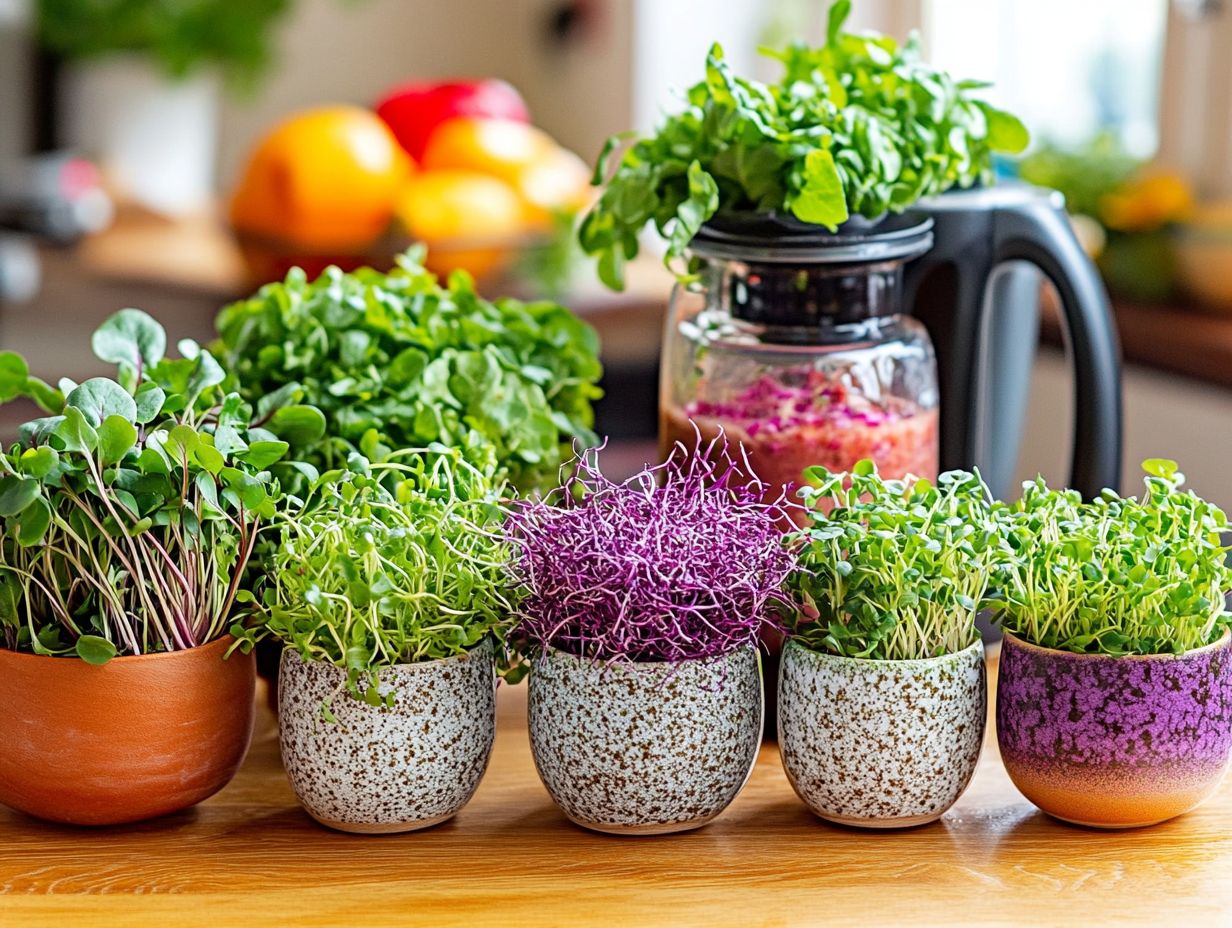
- Microgreens like kale and broccoli are packed with nutrients.
- They are easy to grow at home and provide a boost of vitamins, minerals, and antioxidants.
- Incorporating microgreens into your diet may improve digestion, boost immune function, and support overall health.
1. Kale Microgreens
Kale microgreens are popular for a good reason. They pack a lot of nutrients, meaning they have many vitamins and antioxidants that are great for your health.
These tiny greens are brimming with vitamins A, C, and K, significantly boosting your immune function, skin health, and bone strength. They make a power-packed addition to salads, smoothies, and sandwiches that you won t want to miss.
Their vibrant green hue signals a wealth of chlorophyll and antioxidants, ready to combat oxidative stress in your body. With a mild, slightly peppery flavor, they elevate any dish and integrate seamlessly into a myriad of culinary creations.
Whether you sprinkle them atop entrees or blend them into sauces, their versatility caters to a wide range of palates, proving that healthy eating can be both delicious and beneficial.
2. Broccoli Microgreens
Broccoli microgreens are not just easy to grow; they are also brimming with antioxidants, providing an impressive health boost that makes them a top choice for anyone looking to enrich their diet with nutrient-rich options.
These petite greens pack a higher concentration of vitamins and phytochemicals than their fully grown counterparts, transforming them into a true nutritional powerhouse. With their sulforaphane content, they are renowned for helping to reduce inflammation and enhance overall immunity.
If you’re interested in home gardening, you can easily grow broccoli microgreens with minimal space. They can be effortlessly managed using simple trays and soil, along with adequate light and water.
These microgreens can be incorporated into salads, sandwiches, and smoothies, adding a mild, slightly peppery flavor that elevates your dishes while delivering a wealth of health benefits. To explore different options, check out microgreen varieties: a guide for beginners.
3. Spinach Microgreens
Spinach microgreens are truly a culinary gem, celebrated for their rich flavor and impressive nutrient profile, particularly their high levels of vitamin K. Incorporating these vibrant greens into your salads, smoothies, and garnishes can elevate your meals while boosting your nutrition.
These tender greens not only enhance the taste of your dishes but also play a crucial role in supporting overall health, especially when it comes to bone strength. With their unique, slightly earthy flavor, they add depth without overpowering your culinary creations.
Whether you re a seasoned chef or a home cook, you ll find it easy to include spinach microgreens in pasta dishes, savory omelets, or as a delightful topping for grilled meats. Their versatility invites you to unleash your culinary creativity, allowing you to savor both their delightful flavor and the myriad of health benefits they offer.
4. Pea Shoot Microgreens
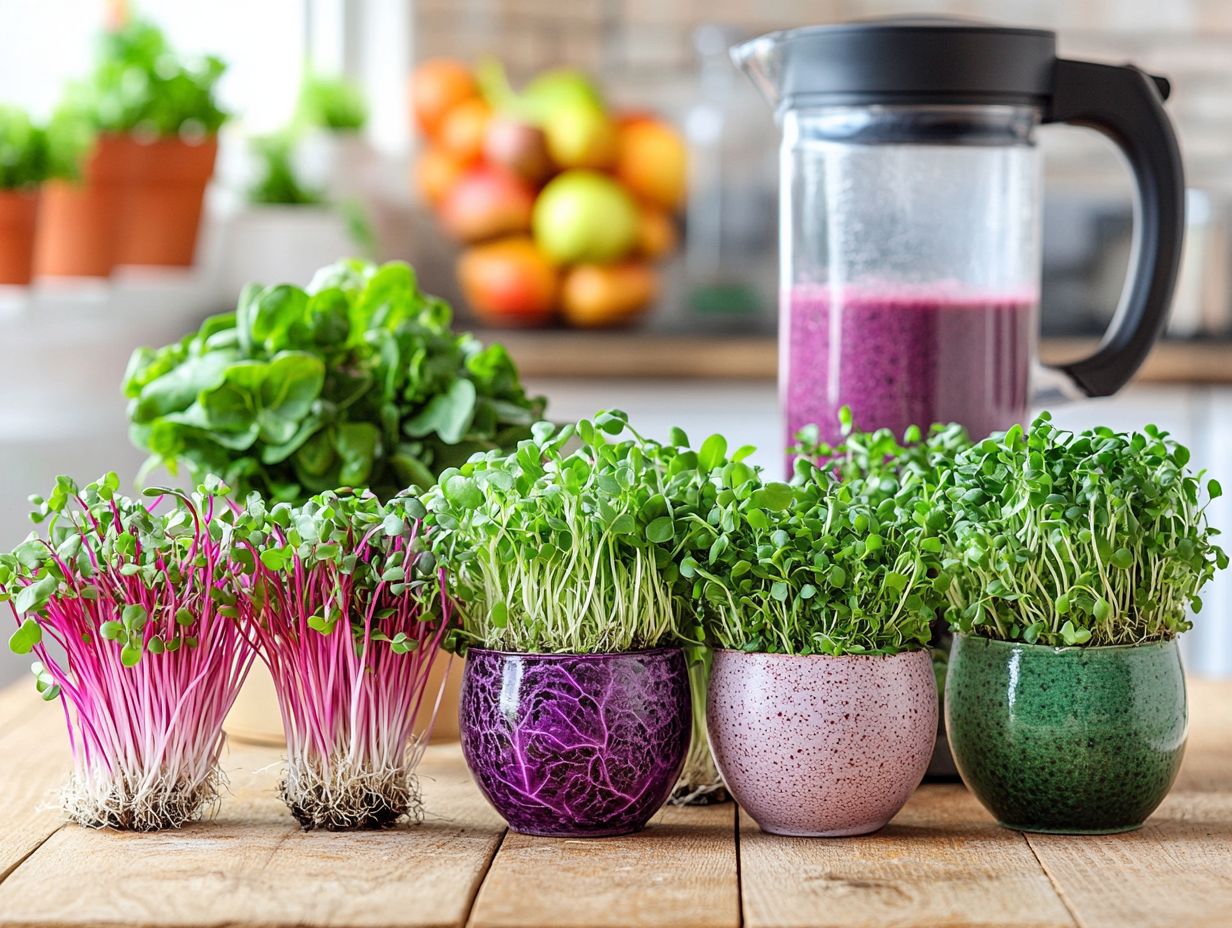
Pea shoot microgreens are quick to harvest and offer a sweet, crisp flavor. They are a must-try for anyone eager to explore microgreens.
These delicate greens sprout within just a week of planting. Start by soaking the seeds overnight and placing them in a shallow tray with light, well-draining soil.
With minimal effort just regular watering and sunlight these vibrant shoots will flourish. Their tender texture and nutty taste make them perfect for salads, stir-fries, or as a colorful garnish.
5. Sunflower Microgreens
Sunflower microgreens are rich in nutrients and have a delightful crunch. They are a favorite among health-conscious eaters and chefs alike.
These greens are packed with vitamin E, which promotes heart health by acting as an antioxidant. They enhance the flavor of dishes and add crunch to salads, sandwiches, and smoothies.
Here are some ways to use sunflower microgreens in cooking:
- Sprinkle them on salads for a fresh touch.
- Add them to smoothies for extra nutrition.
- Use them as a garnish for soups and main dishes.
This versatility boosts the nutritional profile of your meals and adds a nutty flavor that s hard to resist.
What Are Microgreens and Why Are They Good for Smoothies?
Microgreens are young, edible plants harvested just after their first true leaves appear. They provide a great nutritional boost and are perfect for enhancing smoothies.
These nutrient-dense greens come in various types, such as arugula and basil. For instance, basil microgreens add a sweet touch, while radish microgreens offer a peppery kick.
Including microgreens in your smoothies adds vitamins A, C, and K. This means your drinks can be both delicious and packed with health benefits.
How Do Microgreens Compare to Full-Grown Greens in Nutritional Value and Health Benefits?
Microgreens often deliver more nutrients than mature greens. They are rich in vitamins, minerals, and antioxidants, making them a superior choice for health-conscious eaters.
For example, vitamin A is crucial for vision and immune health. Microgreens contain more vitamin A than their grown counterparts.
Vitamin C, known for immune support and tissue recovery, is also found in higher concentrations in these tiny greens. Similarly, vitamin K, essential for blood clotting, is present in greater amounts in microgreens.
Choosing microgreens can enhance your diet and provide a savvy dietary strategy to optimize nutrition.
How to Grow Microgreens at Home for Smoothies?
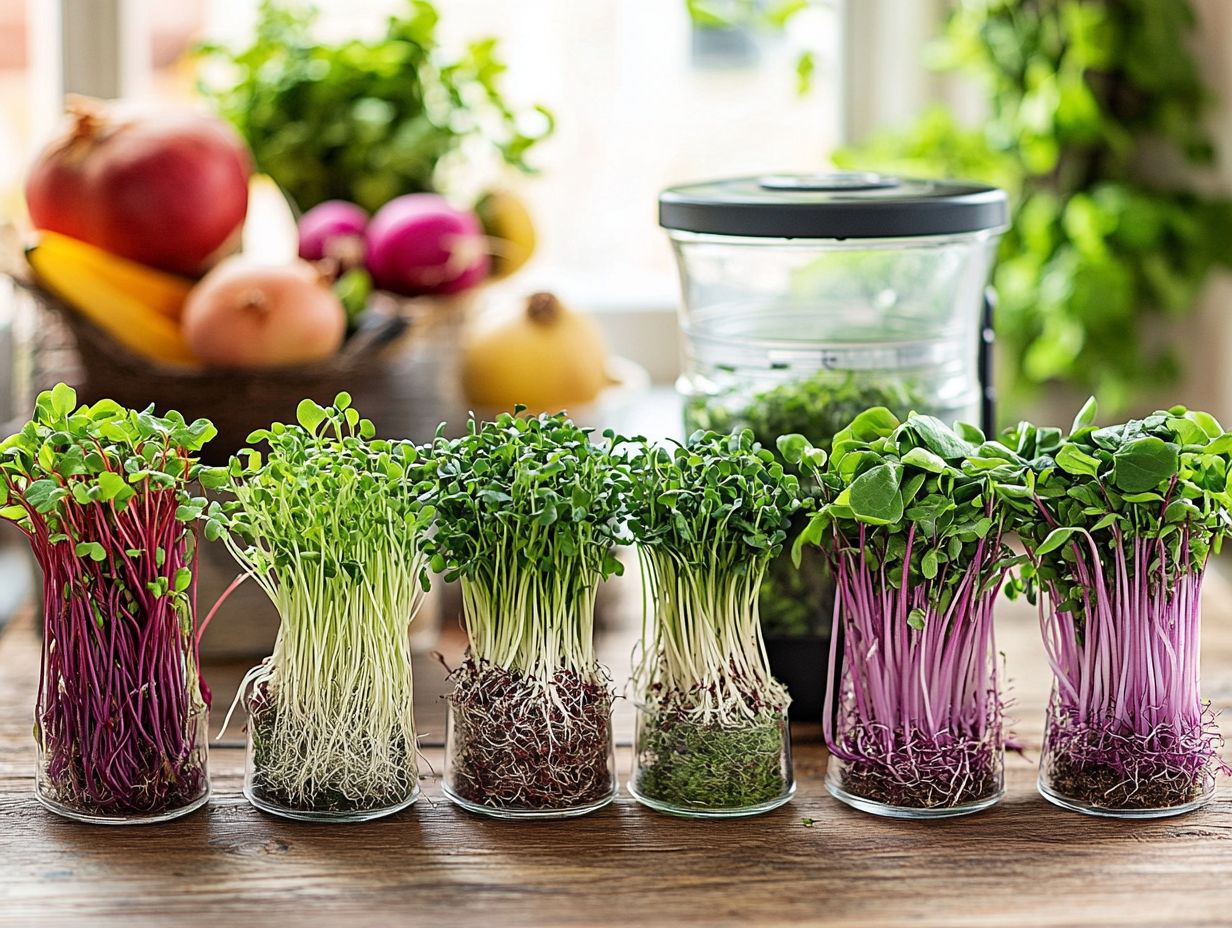
Growing microgreens at home is simple and requires minimal space, making it perfect for anyone eager to add these flavorful delights to their smoothies without needing a large garden.
Even if you have limited sunlight or no outdoor space, you can still enjoy this rewarding gardening experience. Begin by gathering essential materials such as seed trays, high-quality potting soil, and a selection of seeds like radish, sunflower, or basil.
Fill the trays with soil, sprinkle the seeds evenly across the surface, and mist them gently with water. A light cloth over the trays helps maintain humidity during germination.
In about a week, you’ll be ready to harvest and enjoy the freshness that elevates any dish, including pea shoots.
Creative Ways to Add Microgreens to Your Meals
Along with blending seamlessly into your smoothies, microgreens can be incorporated into salads, sandwiches, and garnishes, such as garden cress. They elevate your meals with vibrant flavors and impressive nutritional benefits.
These tiny powerhouses can also enhance your omelets, tacos, and even pizzas, introducing an unexpected burst of flavor that delights the palate.
When crafting a fresh salad, pair peppery arugula microgreens with a citrus vinaigrette to amplify those zesty notes.
For heartier dishes like sandwiches, adding crunchy radish microgreens brings a delightful crunch that contrasts beautifully with creamy spreads.
Imagine using delicate pea shoots atop a warm bowl of ramen, adding a fresh, sweet layer, while basil microgreens enhance a Caprese salad with their aromatic touch. The possibilities are endless!
What Are the Potential Health Benefits of Consuming Microgreens?
Consuming microgreens offers numerous health benefits, including improved nutrient absorption, higher levels of antioxidants, and support for your overall well-being. They are essential for a balanced diet.
These petite greens are packed with vital vitamins such as A, C, E, and K, each playing a crucial role in maintaining immune function and fostering skin health. Vitamin C is a powerful antioxidant that helps combat oxidative stress and may lower your risk of chronic diseases.
The abundant vitamin K in microgreens enhances bone health and supports effective blood clotting. By incorporating a variety of microgreens into your meals, you can boost your nutrition and enhance your body s resilience.
Are There Any Precautions to Take When Consuming Microgreens?
While microgreens are generally safe to consume and packed with health benefits, it’s essential to take certain precautions to minimize potential health risks.
Start with a thorough washing to eliminate any contaminants that may linger on the surface. Sourcing from reputable growers who follow strict food safety practices ensures quality and promotes sustainable farming.
Be aware of potential foodborne illnesses that can arise from mishandling or improper storage. Adopting safe handling practices like keeping microgreens refrigerated and using clean utensils can significantly enhance your experience.
By implementing these measures, you can confidently savor the vibrant benefits that these nutrient-rich plants have to offer.
Frequently Asked Questions
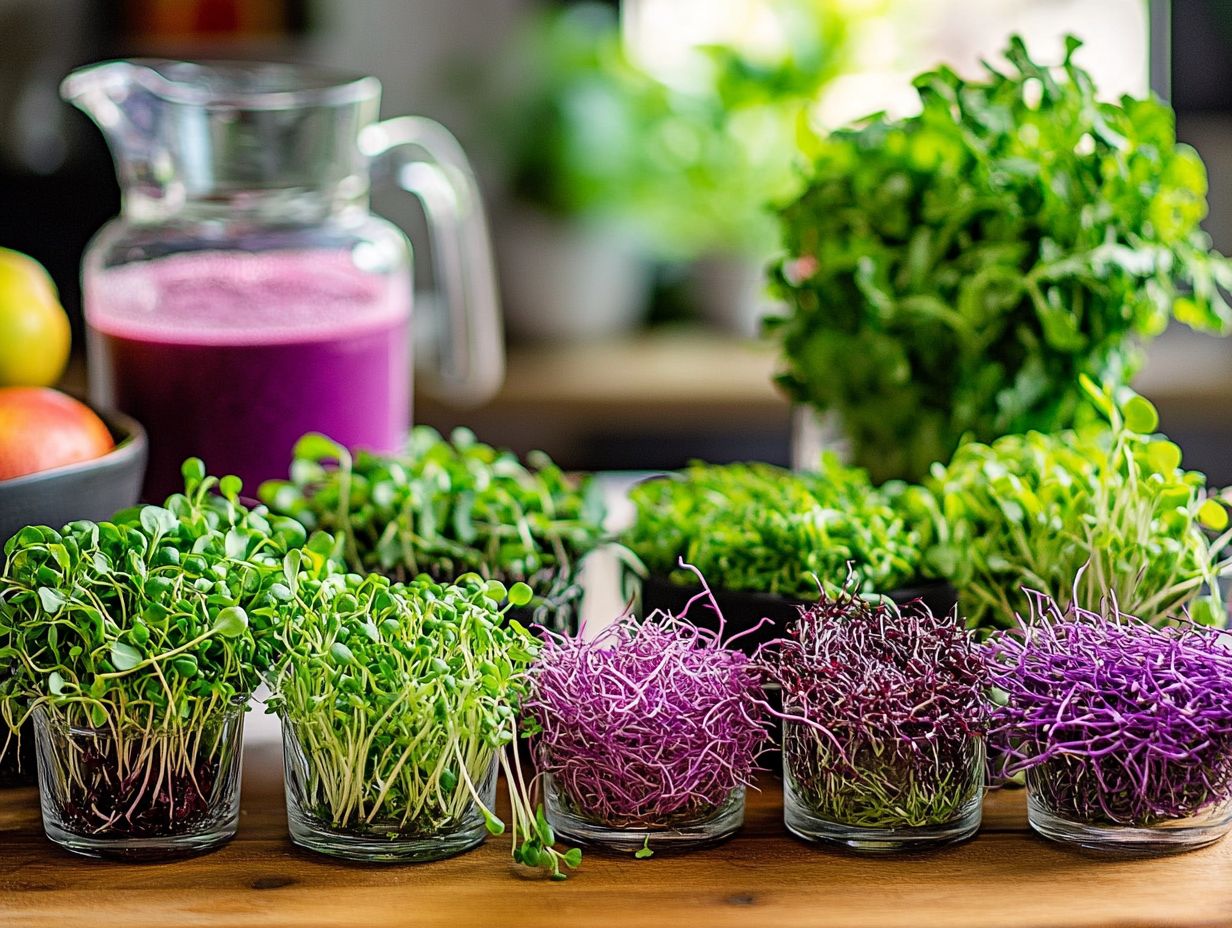
What are the top 5 microgreen varieties to boost your smoothies?
- Kale
- Spinach
- Broccoli
- Wheatgrass
- Pea shoots
Start growing your own microgreens today and taste the difference in your smoothies!
How do microgreens enhance the nutritional value of smoothies?
Microgreens are packed with nutrients, including vitamins, minerals, and antioxidants. They can significantly boost the nutritional value of your smoothies.
Can I grow my own microgreens for smoothies?
Yes, you can grow your own microgreens at home. Just use a flat tray, potting soil, and seeds from your favorite variety.
Are there specific tips for adding microgreens to smoothies?
To add microgreens to smoothies, blend them with fruits, vegetables, and liquids. This creates a balanced and tasty drink.
What flavors do microgreens bring to smoothies?
Microgreens add a burst of fresh, tangy flavor to your smoothies! Each variety offers a unique twist that makes every sip exciting.
Can I use frozen microgreens in my smoothies?
Yes, frozen microgreens are a convenient way to add nutrition and flavor. Just remember to thaw them before blending.

